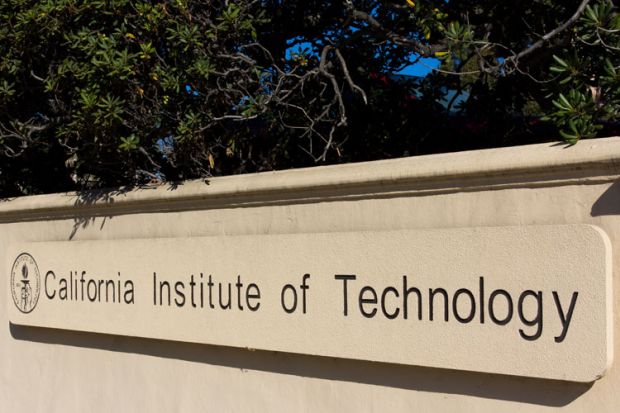Caltech: High School Students Conduct Research with Caltech Mentors
In the subbasement of Caltech’s Seeley W. Mudd Laboratory of the Geological Sciences, three high school students took turns with a sledgehammer to smash speckled gray rocks, remnants of 1.7-billion-year-old oceanic crust. Next, the students slid the resulting chips into a crusher.
Graduate student Amanda Bednarick, the students’ mentor, hopes that analysis of the crushed rocks will help reveal the geochemistry of ancient seas, the subject of her research.
She and the younger students working alongside her are collaborating on this investigation as part of the Summer Research Connection, a program offered since 2008 by Caltech’s Center for Teaching, Learning, and Outreach that invites high school students and teachers from Pasadena Unified School District (PUSD) and other nearby schools into Caltech laboratories.
In 2022, participants joined active research projects led by Caltech astronomers, physicists, biologists, and geoscientists. Three teachers and 29 students participated in the six-week, on-campus program. Another 27 participated in a new, partly online option.
Bednarick designed the students’ experience with Claire Bucholz, assistant professor of geology. Bucholz welcomed and oriented the students, managed protocols and safety training, shared the science behind the project, and tapped discovery funding from Caltech’s Division of Geological and Planetary Sciences to support Bednarick’s participation.
Exploring Geoscience and Caltech
The group toured campus and visited the laboratories of graduate students who study Mars, meteorites, seagrass, climate change, and more.
“I wanted the students to be exposed to what Earth science is and what you can do with geology,” Bednarick says.
“For me, the best part was learning about minerals and meteorites,” says Sienna Lam of Polytechnic School in Pasadena. “I liked visiting the labs. It’s nice how everyone knows each other. It’s a community. Some people are so passionate, like George Rossman (professor of minerology), who told us about minerals.”
“The people are fun to be with,” adds Jonathan Zhao of Temple City High School. “My favorite part was learning about Mars—the rovers, the structures in the basin, the sediments there, and how to find water. And I was surprised that there are so many subfields in geology—geochemistry, mineralogy, geobiology. There are a lot of options to pursue.”
“I liked being able to talk to the graduate students about how much they collaborate across different fields,” says Axayacatzi Kuauhtzin of Anahuacalmecac International University Preparatory of North America in Los Angeles. “I saw that a graduate student studying meteorites can combine geology and astronomy. So much can be contributed by new ways of looking at the project.”
Deep Dive in the Ancient Ocean
To prepare for the research project, Bednarick traveled to the ancestral homelands of the Tonto Apache tribe near Payson, Arizona, with a permit to remove rocks from an outcrop known as an ophiolite. “That’s an ancient sliver of oceanic crust, an association of layers of rocks including basalt and gabbro,” she explains. Tectonic processes exposed the layers of rock, once seafloor. They allow geologists to study the normally inaccessible rocks between the deep sea and Earth’s mantle.
When Bednarick prepared the rocks for the summer students’ effort, she wondered how much progress they would make.
“I’ve been surprised at how quickly they picked everything up,” she says. “They’re hard workers. They ask good questions and have gotten through a lot of samples. It’s valuable for them to see firsthand how much work goes into research. You can’t just put a rock into a machine and get data.”
To complete the project, Bednarick will fuse some of the pulverized rocks into beads and vaporize others, so they can be analyzed in spectrometers. Those instruments will reveal what elements the rocks contain and what proportion of their iron encountered oxygen. Bednarick will use the data to learn about the chemistry of ancient seawater in this area.
The students also helped compile information about ophiolites into a database, soon to be made public, that unifies data scattered in individual publications.
Mutual Learning
Bednarick learns by mentoring. “For example, one of my students is Indigenous and it’s been valuable to hear her perspectives on land acknowledgments,” she says. “In geology, there’s a push to make sure that all rock sampling is done with the proper permissions. But it’s not carried out that way across the board yet.”
Kuauhtzin said that it was important to her to bring her background and perspective to the work. “Since I’m Indigenous, I see ways that scientists exploit people and hurt the environment to do their research,” she said. “The scientific work is important, but a lot of people don’t have cultural consideration and don’t acknowledge that tribes have been taking care of this land since time immemorial. They don’t understand that all of the land was stolen. I hope I can change that.”
Bednarick appreciates what she learns by mentoring younger students and also wants to provide young people with opportunities like those that brought her to geoscience. She volunteers with GO Outdoors, a program in Caltech’s Division of Geological and Planetary Sciences led by graduate students who partner with PUSD teachers to provide field-based geoscience education.
“When I was an undergraduate, people in my department took me under their wing,” Bednarick says. “They gave me opportunities to go into the field and conduct research with them. Those experiences and people are a large part of the reason I ended up here. I want to give back. Mentoring also helps me gain teaching skills. Explaining complicated concepts in simple ways is a valuable skill that takes practice to hone, and managing people has given me new perspectives on leadership and task management.”
Through mentoring, Bednarick says she can connect her work life with the community where she lives. “There is amazing geology right in our backyard, and I want to help local students experience it who might not be getting a full earth science curriculum in school,” she says.

